Evaluating the Suitability of a Smart Technology Application for Fall Detection Using a Fuzzy Collaborative Intelligence Approach
Abstract
1. Introduction
- (1)
- Most of the past studies in this field just listed the criteria for choosing a suitable smart technology application for fall detection, the conclusions of which cannot be applied to perform a quantitative and precise comparison;
- (2)
- Some studies, such as De Lima et al. [16], conducted experimentation to compare the suitabilities of smart technology applications for fall detection. However, only very few specific smart technology applications were compared.
- (1)
- The fuzzy collaborative intelligence approach is a posterior-aggregation FAHP method, while most existing group-based FAHP methods are anterior-aggregation methods [20];
- (2)
- In the fuzzy collaborative intelligence approach, decision makers’ judgments are aggregated using FI, while in existing group-based FAHP methods, decision makers’ judgement are usually aggregated using FGM. FI can help check the existence of a consensus, and is considered to be better than FGM [21];
- (3)
- Although there have been some studies combining FAHP and fuzzy TOPSIS, these studies approximated, rather than derived, the values of fuzzy weights by applying FGM or fuzzy extent analysis (FEA) [22,23]. In contrast, the fuzzy collaborative intelligence approach derived the values of fuzzy weights by applying ACO;
- (4)
- Most of the past studies applied FWA instead of fuzzy TOPSIS to assess the sustainability or suitability of a smart technology application. Compared to FWA, fuzzy TOPSIS is more sensitive in detecting a minor difference in sustainability or suitability.
2. Literature Review
2.1. Smart Technology Applications for Fall Detection
2.2. Fuzzy TOPSIS
3. The Proposed Methodology
3.1. Deriving the Fuzzy Weights of Criteria Using ACO
- As important as: = (1, 1, 5),
- Slightly more important than: = (1, 3, 7),
- Considerably more important than: = (1, 5, 9),
- Extremely more important than: = (3, 7, 9),
- Absolutely more important than: = (5, 9, 9).
3.2. Aggregating the Fuzzy Weights Derived by All Decision Makers Using FI
3.3. Assessing the Suitability of a Smart Technology Application Using Fuzzy TOPSIS
3.4. Defuzzifying the Assessment Result Using COG
4. Application
- (1)
- (2)
- Attaching proximity sensors to the walking aid (such as a cane or a walker) of the subject. A sudden movement of the subject or an increased distance between the subject and the walking aid can be interpreted as a possible fall [9];
- (3)
- Covering the floor with a smart carpet or smart tiles. Then, a possible fall can be detected if a number of the embedded pressure sensors are activated simultaneously [14];
- (4)
- (1)
- (2)
- (3)
- C3: privacy [1];
- (4)
- (5)
- Very poor: (1, 1, 2);
- Poor: (1, 2, 3);
- Moderate: (2, 3, 4);
- Good: (3, 4, 5);
- Very good: (4, 5, 5).
- (1)
- Among the four smart technology applications for fall detection, the application of smart carpet achieved the highest suitability, which was obviously due to its capability of detecting multiple subjects’ falls simultaneously and the protection of a subject’s privacy;
- (2)
- In contrast, the application of a smart cane was considered the least suitable. A smart cane could support only a single subject, which made it relatively expensive;
- (3)
- For a comparison, three existing methods, FGM-FWA, FEA-FWA, and FGM-ACO-FWA [17], were also applied to assess the same smart technology applications for fall detection. In FGM-FWA, decision makers’ judgments were aggregated using FGM. The fuzzy weights of criteria were also approximated using FGM. Then, FWA was applied to assess the suitability of each same smart technology application for fall detection. In FEA-WA, decision makers’ judgments were aggregated using FGM as well. Then, the weights were estimated using FEA in crisp values. Nevertheless, the performances in optimizing the criteria were expressed in fuzzy values. Therefore, FWA was still applied to assess the suitability of each same smart technology application for fall detection. FGM-ACO-FWA is an anterior-aggregation FAHP method, i.e., experts’ judgments were aggregated using FGM before deriving a single set of fuzzy weights using ACO. The ranking results obtained using various methods are compared in Figure 9. Obviously, the ranking result using the proposed methodology was somewhat different from those using existing methods. According to the proposed methodology, a smart surveillance system was more suitable than the combination of smart phone/watch and app, while existing methods drew the opposite conclusion;
- (4)
- In existing methods, FWA was applied to assess the suitability of a smart technology application for fall detection, in which the weighted performance in optimizing a criterion could be compensated directly (or linearly) by that in optimizing another. In contrast, in the fuzzy collaborative intelligence approach, fuzzy TOPSIS was applied for the same purpose, in which the weighted performance was involved in a quadratic function (i.e., the Euclidean distance) that magnified the difference between the weighted performances of two methods. As a result, fuzzy TOPSIS was considered to be more sensitive than FWA;
- (5)
5. Conclusions
- (1)
- Five factors critical to the applications of smart technologies for fall detection were identified as unobtrusiveness, the simultaneous application to multiple subjects, privacy, the purchasing, installation, computation, and energy costs, and the correct, reliable, and robust identification of a fall;
- (2)
- Among the four smart technology applications for fall detection, the most and least suitable applications were smart carpet and smart cane, respectively;
- (3)
- The ranking result using the proposed methodology was somewhat different from those using three existing methods.
Author Contributions
Funding
Conflicts of Interest
References
- Delahoz, Y.S.; Labrador, M.A. Survey on fall detection and fall prevention using wearable and external sensors. Sensors 2014, 14, 19806–19842. [Google Scholar] [CrossRef] [PubMed]
- Noury, N.; Fleury, A.; Rumeau, P.; Bourke, A.; Laighin, G.; Rialle, V.; Lundy, J. Fall Detection-Principles and Methods. In Proceedings of the 29th Annual International Conference of the IEEE Engineering in Medicine and Biology Society, Lyon, France, 23–26 August 2007; pp. 1663–1666. [Google Scholar]
- Dörr, S.; Schickel, R.; Lucke-Paulig, L.; Schöntag, S.; Lobmann, R. Rapid cognitive decline and recurrent falls in a 71 year-old man due to cerebral amyloidangiopathy-related inflammation (CAA-RI). Geriatrics 2019, 4, 56. [Google Scholar] [CrossRef] [PubMed]
- Gurley, R.J.; Lum, N.; Sande, M.; Lo, B.; Katz, M.H. Persons found in their homes helpless or dead. N. Engl. J. Med. 1996, 334, 1710–1716. [Google Scholar] [CrossRef] [PubMed]
- Wang, Y.; Wu, K.; Ni, L.M. Wifall: Device-free fall detection by wireless networks. IEEE Trans. Mob. Comput. 2016, 16, 581–594. [Google Scholar] [CrossRef]
- Khan, S.S.; Hoey, J. Review of fall detection techniques: A data availability perspective. Med. Eng. Phys. 2017, 39, 12–22. [Google Scholar] [CrossRef]
- Jordan, M. What is ‘Smart’ Technology? 2011. Available online: http://knowit.co.nz/2011/08/what-is-smart-technology (accessed on 12 July 2019).
- Chen, T.; Chiu, M.-C. Smart technologies for assisting the life quality of persons in a mobile environment: A review. J. Ambient Intell. Humaniz. Comput. 2018, 9, 319–327. [Google Scholar] [CrossRef]
- Hirata, Y.; Komatsuda, S.; Kosuge, K. Fall prevention control of passive intelligent walker based on human model. In Proceedings of the 2008 IEEE/RSJ International Conference on Intelligent Robots and Systems, Nice, France, 22–26 September 2008; pp. 1222–1228. [Google Scholar]
- Lauterbach, C.; Jung, S. Integrated microelectronics for smart textiles. In Ambient Intelligence; Springer: Berlin/Heidelberg, Germany, 2005; pp. 31–47. [Google Scholar]
- Bohn, J.; Coroamă, V.; Langheinrich, M.; Mattern, F.; Rohs, M. Social, economic, and ethical implications of ambient intelligence and ubiquitous computing. In Ambient Intelligence; Springer: Berlin/Heidelberg, Germany, 2005; pp. 5–29. [Google Scholar]
- Ojetola, O.; Gaura, E.I.; Brusey, J. Fall detection with wearable sensors--safe (Smart Fall Detection). In Proceedings of the 2011 Seventh International Conference on Intelligent Environments, Nottingham, UK, 25–28 July 2011; pp. 318–321. [Google Scholar]
- Casilari, E.; Oviedo-Jiménez, M.A. Automatic fall detection system based on the combined use of a smartphone and a smartwatch. PLoS ONE 2015, 10, e0140929. [Google Scholar] [CrossRef]
- Daher, M.; Diab, A.; El Najjar, M.E.B.; Khalil, M.A.; Charpillet, F. Elder tracking and fall detection system using smart tiles. IEEE Sens. J. 2016, 17, 469–479. [Google Scholar] [CrossRef]
- Mubashir, M.; Shao, L.; Seed, L. A survey on fall detection: Principles and approaches. Neurocomputing 2013, 100, 144–152. [Google Scholar] [CrossRef]
- De Lima, A.L.S.; Evers, L.J.; Hahn, T.; Bataille, L.; Hamilton, J.L.; Little, M.A.; Okuma, Y.; Bloem, B.R.; Faber, M.J. Freezing of gait and fall detection in Parkinson’s disease using wearable sensors: A systematic review. J. Neurol. 2017, 264, 1642–1654. [Google Scholar] [CrossRef]
- Chen, T.-C.T. Evaluating the sustainability of a smart technology application to mobile health care: The FGM–ACO–FWA approach. Complex Intell. Syst. 2019, 1–13. [Google Scholar] [CrossRef]
- Chen, T.-C.T. Guaranteed-consensus posterior-aggregation fuzzy analytic hierarchy process method. Neural Comput. Appl. 2019, 1–12. [Google Scholar] [CrossRef]
- Kutlu, A.C.; Ekmekçioğlu, M. Fuzzy failure modes and effects analysis by using fuzzy TOPSIS-based fuzzy AHP. Expert Syst. Appl. 2012, 39, 61–67. [Google Scholar] [CrossRef]
- Wang, Y.-C.; Chen, T.; Yeh, Y.-L. Advanced 3D printing technologies for the aircraft industry: A fuzzy systematic approach for assessing the critical factors. Int. J. Adv. Manuf. Technol. 2018, 1–11. [Google Scholar] [CrossRef]
- Wang, Y.C.; Chen, T.C.T. A partial-consensus posterior-aggregation FAHP method—Supplier selection problem as an example. Mathematics 2019, 7, 179. [Google Scholar] [CrossRef]
- Sirisawat, P.; Kiatcharoenpol, T. Fuzzy AHP-TOPSIS approaches to prioritizing solutions for reverse logistics barriers. Comput. Ind. Eng. 2018, 117, 303–318. [Google Scholar] [CrossRef]
- Chen, T.; Lin, Y.C.; Chiu, M.C. Approximating alpha-cut operations approach for effective and efficient fuzzy analytic hierarchy process analysis. Appl. Soft Comput. 2019, 105855. [Google Scholar] [CrossRef]
- Li, Q.; Stankovic, J.A.; Hanson, M.A.; Barth, A.T.; Lach, J.; Zhou, G. Accurate, Fast Fall Detection Using Gyroscopes and Accelerometer-Derived Posture Information. In Proceedings of the 2009 Sixth International Workshop on Wearable and Implantable Body Sensor Networks, Berkeley, CA, USA, 3–5 June 2009; pp. 138–143. [Google Scholar]
- Phelan, D. Week in Wearables: Apple Watch Fall Detection, Samsung Gear Battery Issues, Swatch Smartwatch. Available online: https://www.forbes.com/sites/davidphelan/2018/10/25/week-in-wearables-apple-watch-fall-detection-samsung-gear-battery-issues-swatch-smartwatch/#17a5d9c4b514 (accessed on 3 July 2019).
- Byron, E. Best Fall Detection Apps for iOS and Android. 2018. Available online: https://reviewster.com/best-fall-detection-apps-for-ios-and-android/ (accessed on 22 July 2019).
- Chen, T.C.T.; Chiu, M.C. Mining the preferences of patients for ubiquitous clinic recommendation. Health Care Manag. Sci. 2018, 1–12. [Google Scholar] [CrossRef]
- Senouci, B.; Charfi, I.; Heyrman, B.; Dubois, J.; Miteran, J. Fast prototyping of a SoC-based smart-camera: A real-time fall detection case study. J. Real Time Image Process. 2016, 12, 649–662. [Google Scholar] [CrossRef]
- Miao, S.; Chen, G.; Ning, X.; Zi, Y.; Ren, K.; Bing, Z.; Knoll, A.C. Neuromorphic benchmark datasets for pedestrian detection, action recognition, and fall detection. Front. Neurorobotics 2019, 13, 38. [Google Scholar] [CrossRef]
- Chiu, M.C.; Chen, T.C.T. Assessing sustainable effectiveness of the adjustment mechanism of a ubiquitous clinic recommendation system. Health Care Manag. Sci. 2019, 1–10. [Google Scholar] [CrossRef] [PubMed]
- Hošková-Mayerová, Š.; Talhofer, V.; Hofmann, A.; Kubíček, P. Mathematical model used in decision-making process with respect to the reliability of geodatabase. In Advanced Dynamic Modeling of Economic and Social Systems; Springer: Berlin/Heidelberg, Germany, 2013; pp. 143–162. [Google Scholar]
- Chen, C.T. Extensions of the TOPSIS for group decision-making under fuzzy environment. Fuzzy Sets Syst. 2000, 114, 1–9. [Google Scholar] [CrossRef]
- Wang, J.W.; Cheng, C.H.; Huang, K.C. Fuzzy hierarchical TOPSIS for supplier selection. Appl. Soft Comput. 2009, 9, 377–386. [Google Scholar] [CrossRef]
- Büyüközkan, G.; Çifçi, G. A novel hybrid MCDM approach based on fuzzy DEMATEL, fuzzy ANP and fuzzy TOPSIS to evaluate green suppliers. Expert Syst. Appl. 2012, 39, 3000–3011. [Google Scholar] [CrossRef]
- Junior, F.R.L.; Osiro, L.; Carpinetti, L.C.R. A comparison between Fuzzy AHP and Fuzzy TOPSIS methods to supplier selection. Appl. Soft Comput. 2014, 21, 194–209. [Google Scholar] [CrossRef]
- Saaty, T.L. The Analytic Hierarchy Process; McGraw-Hill: New York, NY, USA, 1980. [Google Scholar]
- Wang, Y.-C.; Chen, T.-C.T. A direct-solution fuzzy collaborative intelligence approach for yield forecasting in semiconductor manufacturing. Procedia Manuf. 2018, 17, 110–117. [Google Scholar] [CrossRef]
- Chang, D.-Y. Applications of the extent analysis method on fuzzy AHP. Eur. J. Oper. Res. 1996, 95, 649–655. [Google Scholar] [CrossRef]
- Csutora, R.; Buckley, J.J. Fuzzy hierarchical analysis: The Lambda-Max method. Fuzzy Sets Syst. 2001, 120, 181–195. [Google Scholar] [CrossRef]
- Chen, T. Estimating unit cost using agent-based fuzzy collaborative intelligence approach with entropy-consensus. Appl. Soft Comput. 2018, 73, 884–897. [Google Scholar] [CrossRef]
- Yolcu, O.C.; Yolcu, U.; Egrioglu, E.; Aladag, C.H. High order fuzzy time series forecasting method based on an intersection operation. Appl. Math. Model. 2016, 40, 8750–8765. [Google Scholar] [CrossRef]
- Chen, T.-C.T.; Honda, K. Fuzzy Collaborative Forecasting and Clustering: Methodology, System Architecture, and Applications; Springer: Berlin/Heidelberg, Germany, 2019. [Google Scholar]
- Van Broekhoven, E.; De Baets, B. Fast and accurate center of gravity defuzzification of fuzzy system outputs defined on trapezoidal fuzzy partitions. Fuzzy Sets Syst. 2006, 157, 904–918. [Google Scholar] [CrossRef]
- Cucchiara, R.; Prati, A.; Vezzani, R. A multi-camera vision system for fall detection and alarm generation. Expert Syst. 2007, 24, 334–345. [Google Scholar] [CrossRef]
- Miaou, S.-G.; Sung, P.-H.; Huang, C.-Y. A customized human fall detection system using omni-camera images and personal information. In Proceedings of the 1st Transdisciplinary Conference on Distributed Diagnosis and Home Healthcare, Arlington, VA, USA, 2–4 April 2006; pp. 39–42. [Google Scholar]
- Reza Afshari, A. Selection of construction project manager by using Delphi and fuzzy linguistic decision making. J. Intell. Fuzzy Syst. 2015, 28, 2827–2838. [Google Scholar] [CrossRef]
- Chen, T.C.T. Ubiquitous clinic recommendation by predicting a patient’s preferences. Electron. Commer. Res. Appl. 2017, 23, 14–23. [Google Scholar] [CrossRef]
- Pamučar, D.; Stević, Ž.; Sremac, S. A new model for determining weight coefficients of criteria in mcdm models: Full consistency method (fucom). Symmetry 2018, 10, 393. [Google Scholar] [CrossRef]
- Chen, T.; Wang, Y.C. Estimating simulation workload in cloud manufacturing using a classifying artificial neural network ensemble approach. Robot. Comput. Integr. Manuf. 2016, 38, 42–51. [Google Scholar] [CrossRef]

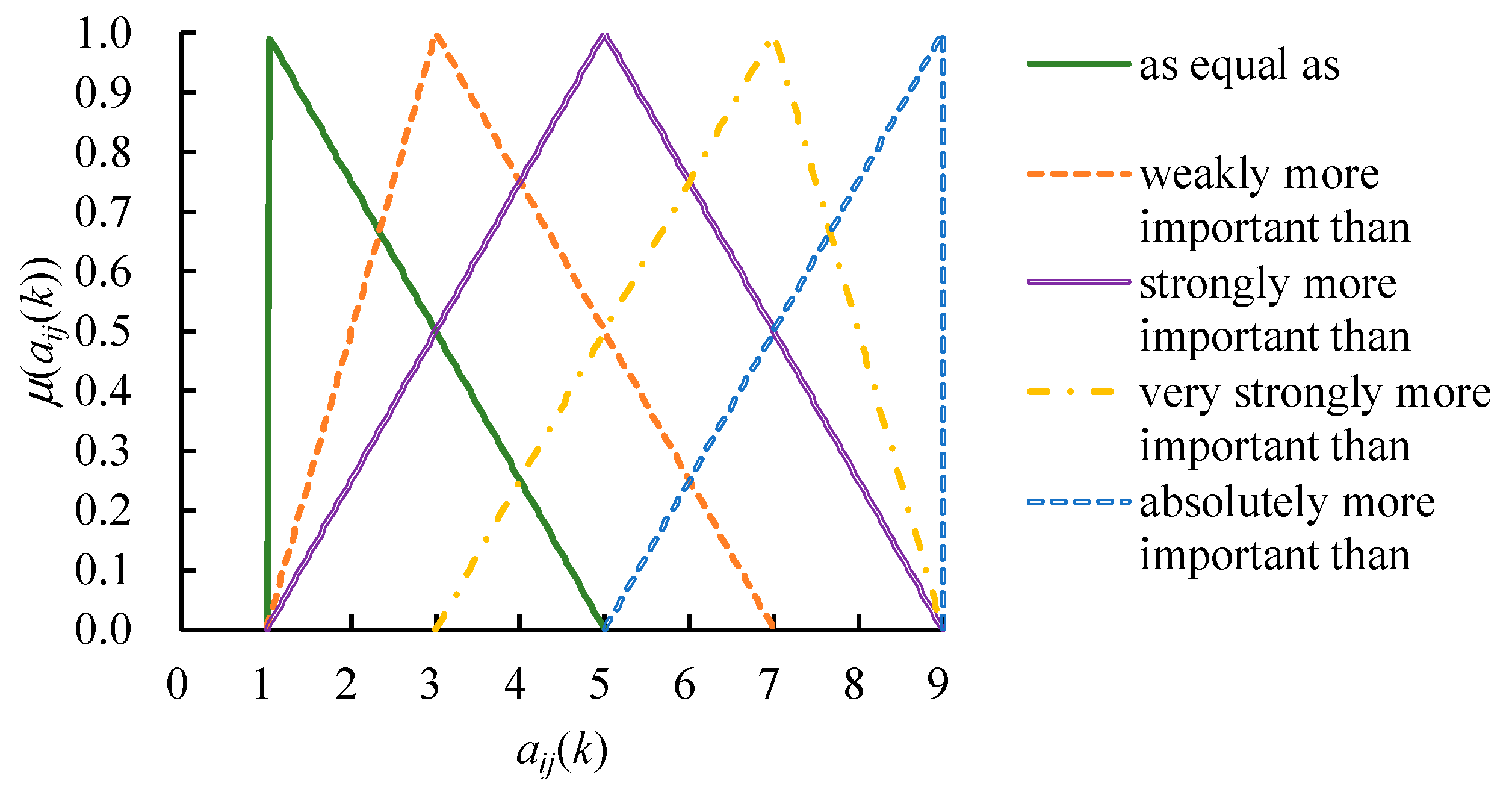
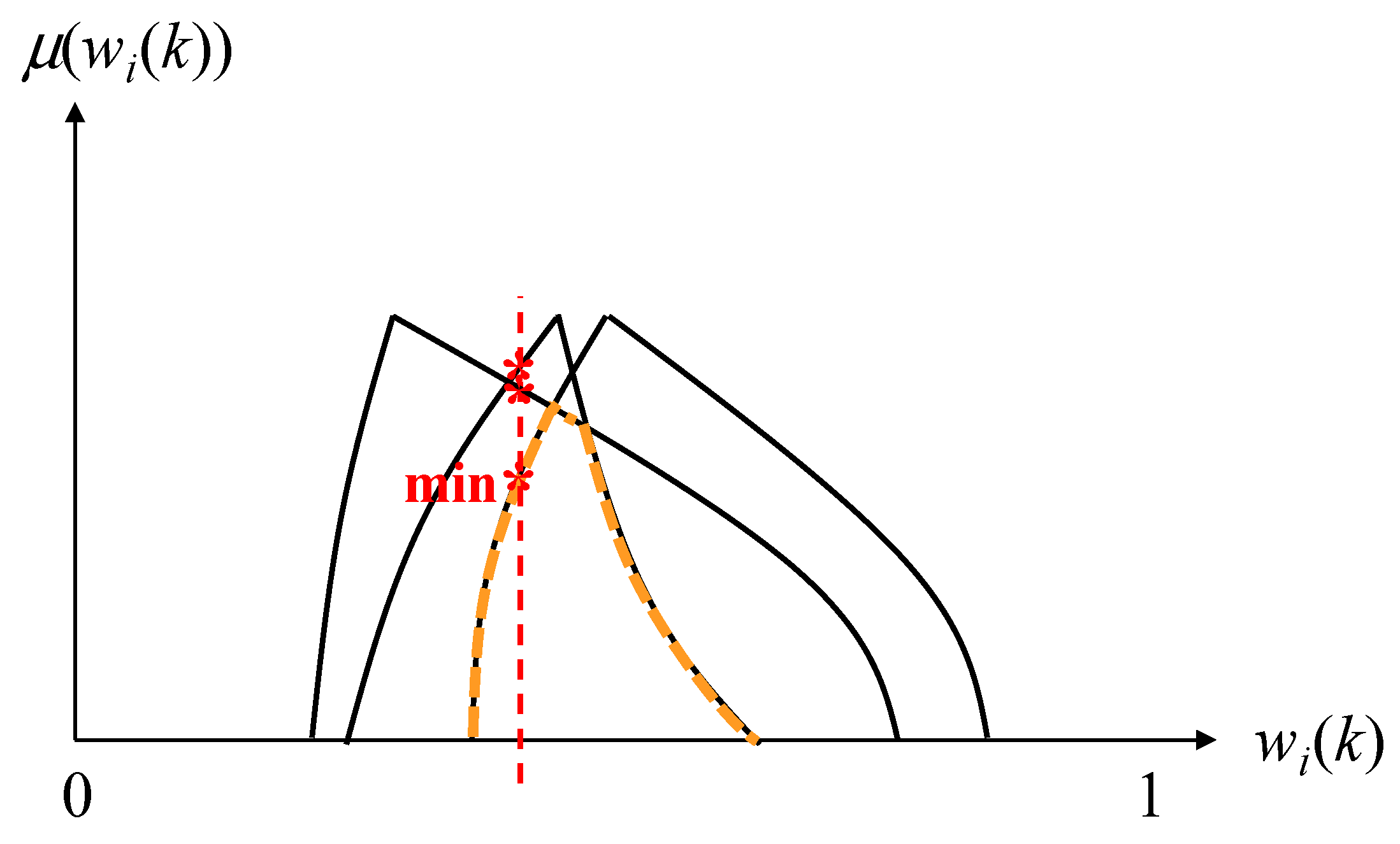
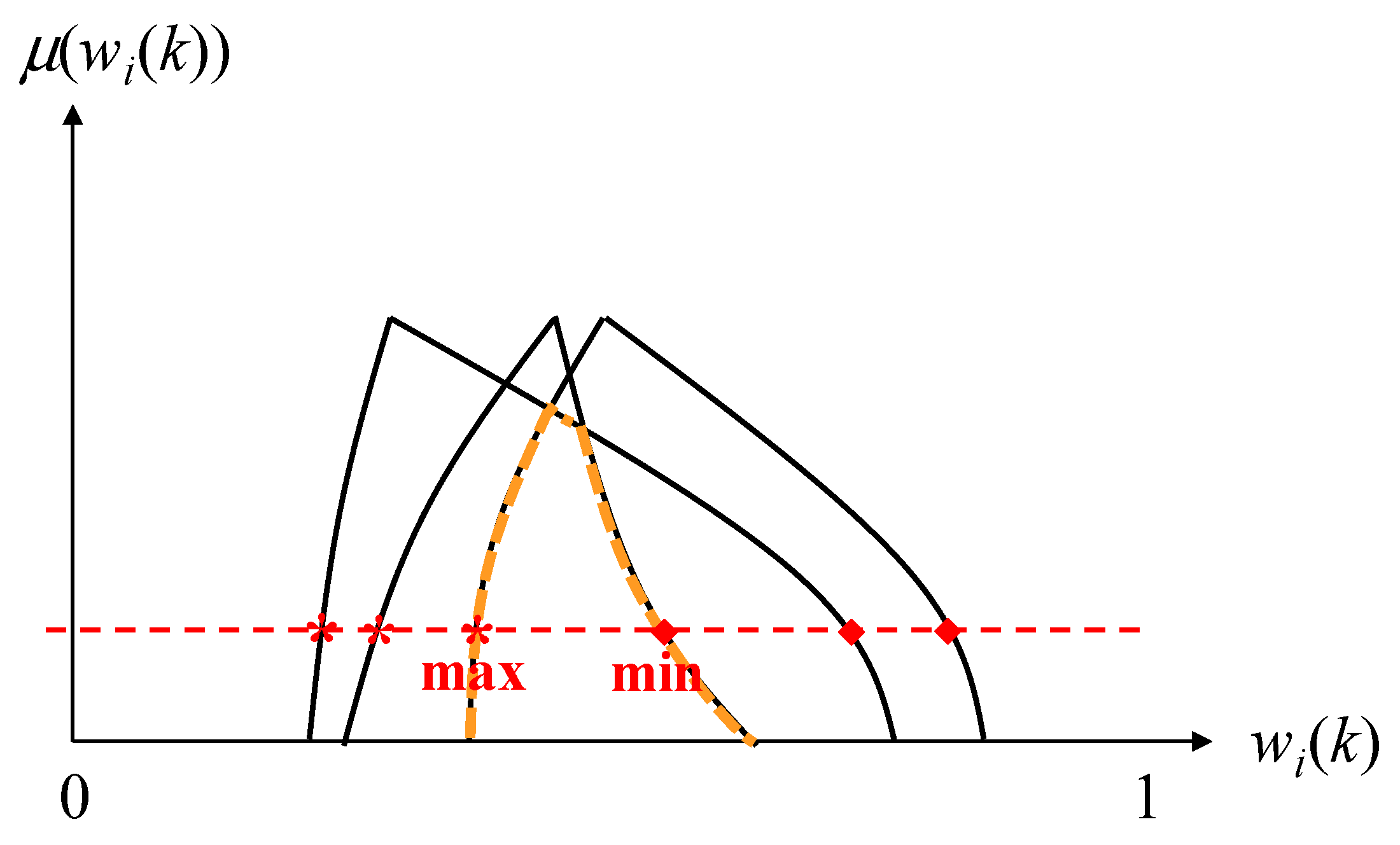
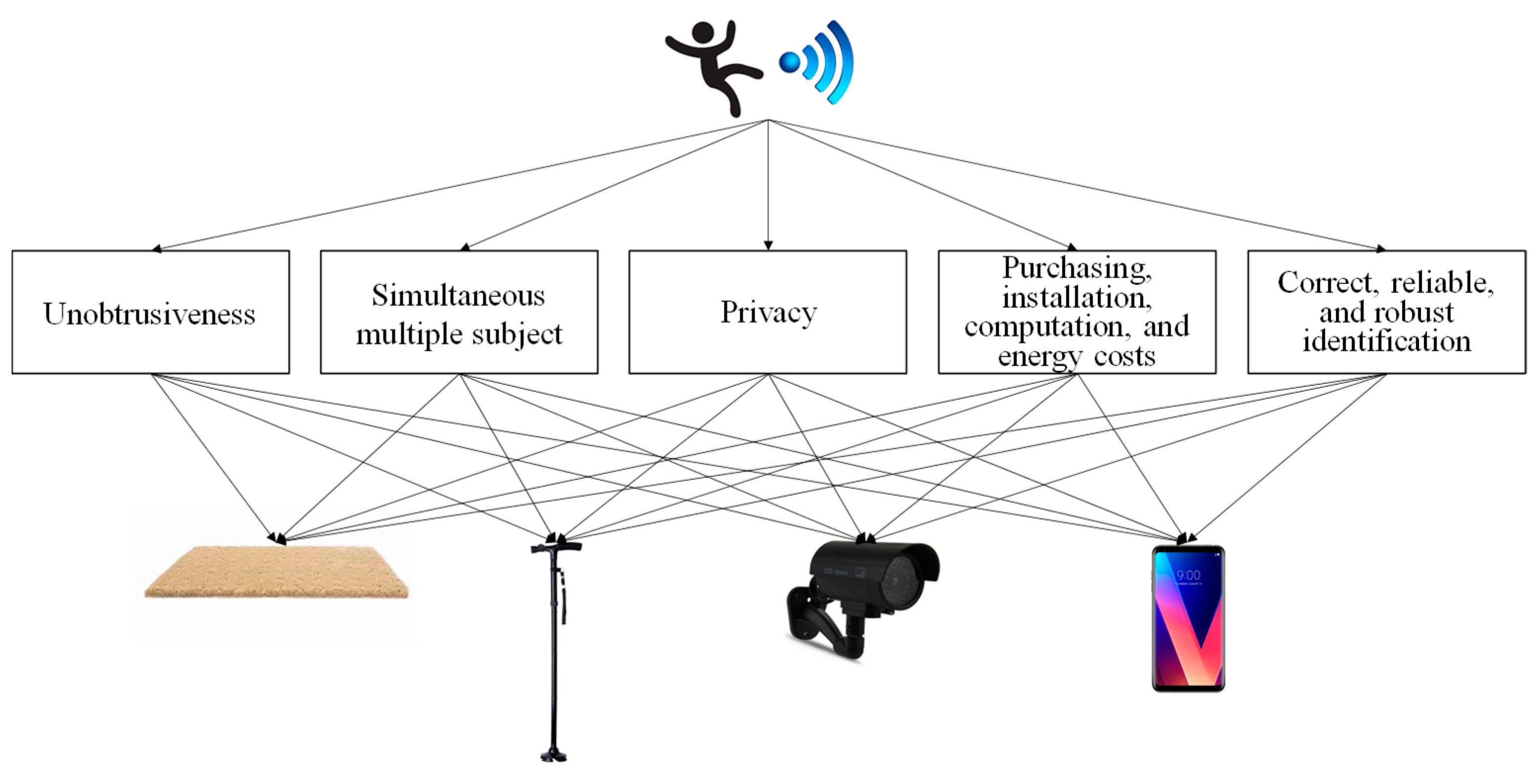
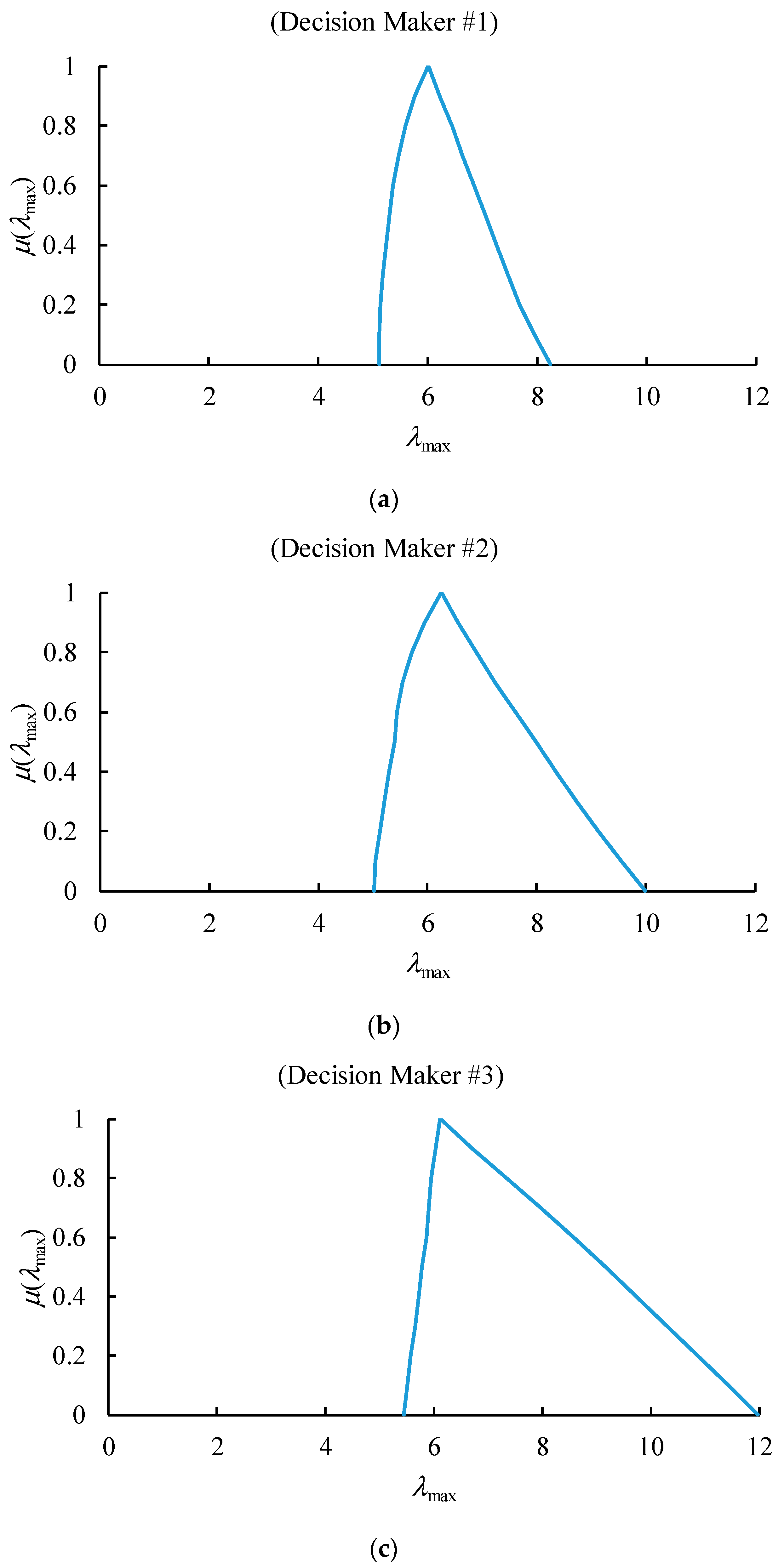
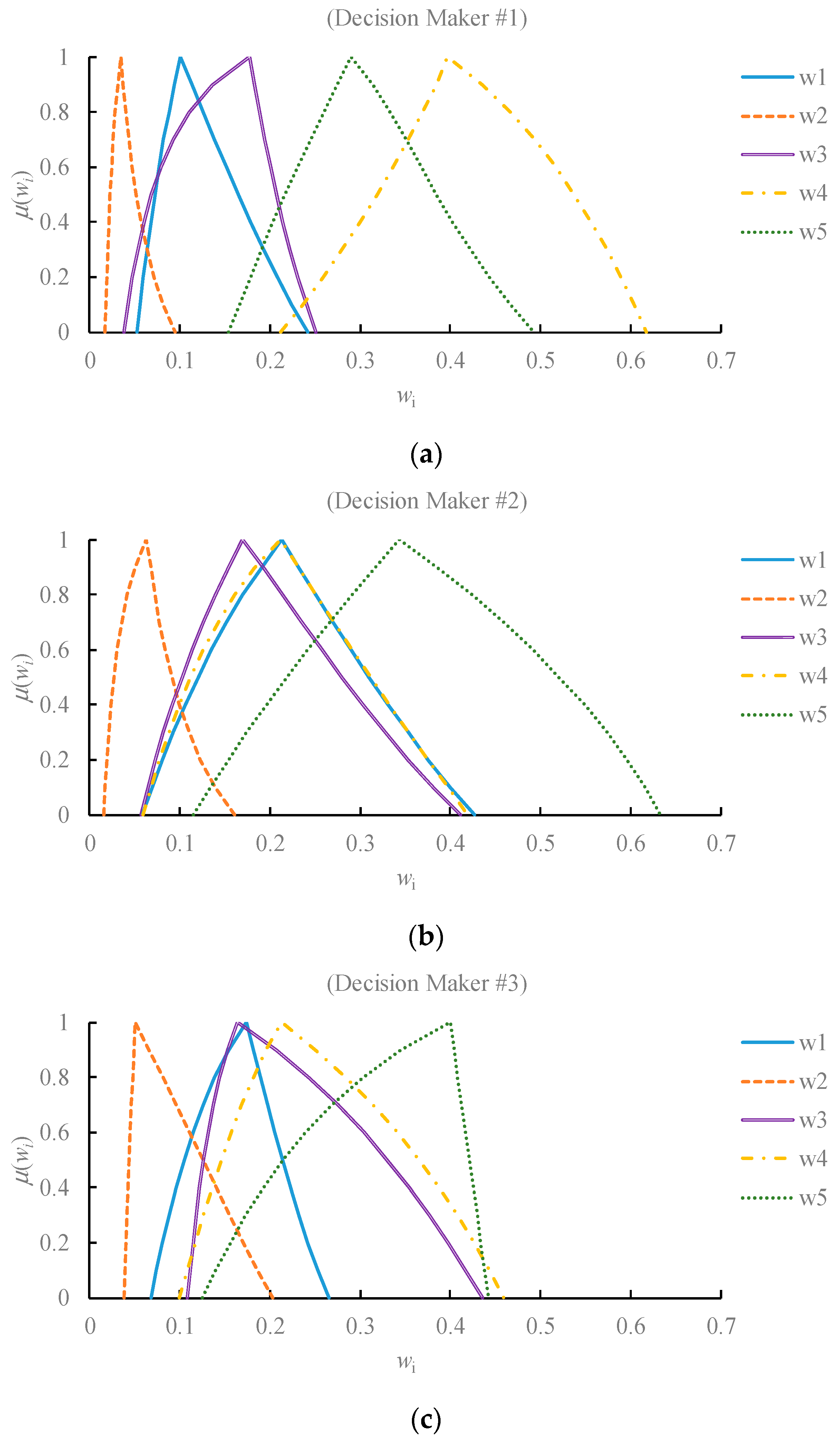
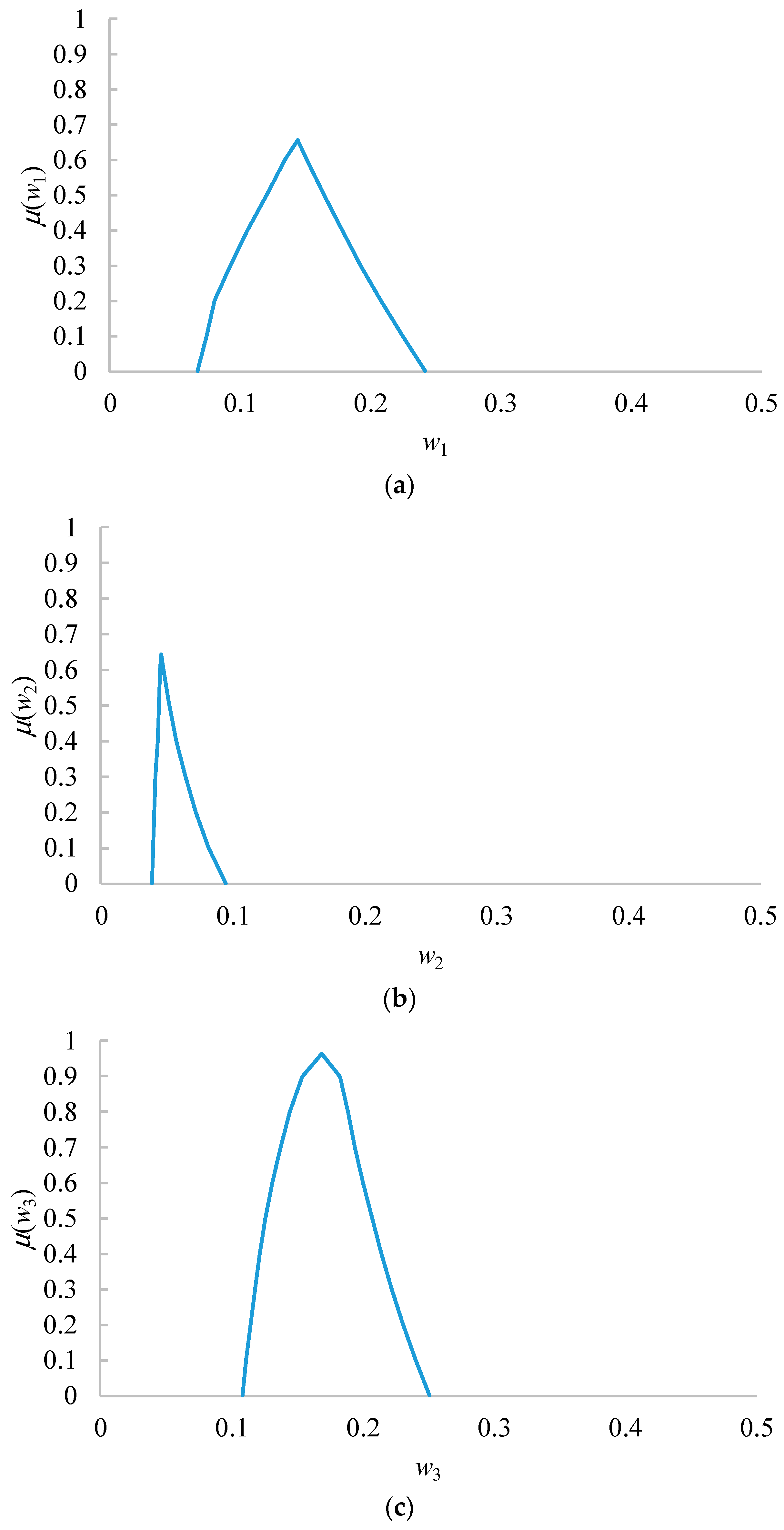
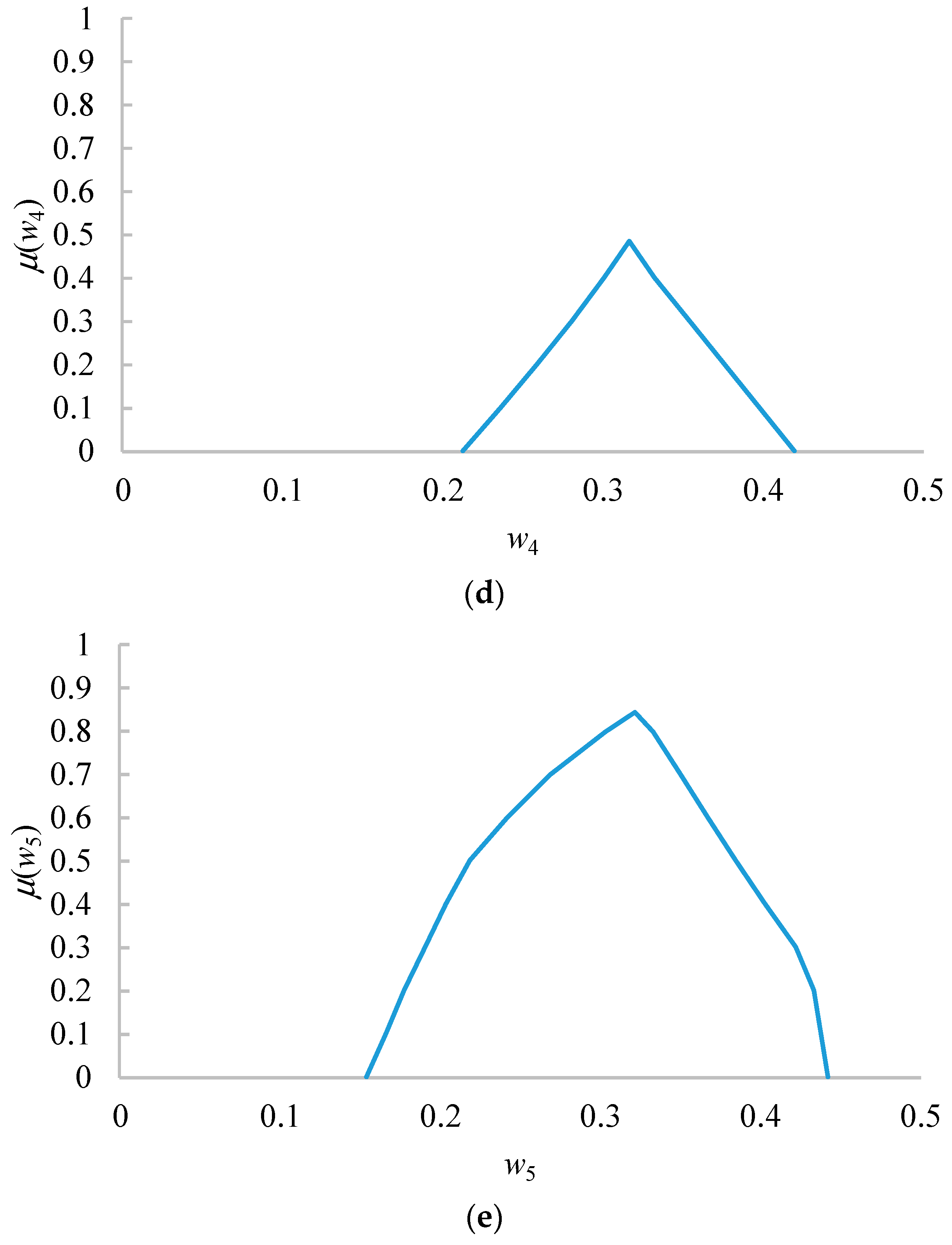

| Method | Smart Technology | Assessment Method | Group Decision Making | Consensus | Aggregation |
|---|---|---|---|---|---|
| Mubashir et al. [15] | All | Criteria to check | No | ||
| De Lima et al. [16] | Smart sensors | Experimentation | No | ||
| Chen [17] | All | FGM-ACO-FWA | Yes | Not guaranteed | Anterior-aggregation |
| The proposed methodology | All | ACO-FI-fuzzy TOPSIS | Yes | Guaranteed | Posterior-aggregation |
| C1 | C2 | C3 | C4 | C5 | |
|---|---|---|---|---|---|
| C1 | 1 | (3, 7, 9), (1, 5, 9), (5, 9, 9) | (1, 1, 5), 1/(1, 3, 7), 1/(1, 1, 5) | 1/(3, 7, 9), (1, 3, 7), 1/(1, 1, 5) | 1/(5, 9, 9), 1/(1, 3, 7), 1/(3, 7, 9) |
| C2 | 1/(3, 7, 9), 1/(1, 5, 9), 1/(5, 9, 9) | 1 | 1/(1, 3, 7), 1/(1, 1, 5), (1, 1, 5) | 1/(3, 7, 9), 1/(1, 3, 7), 1/(3, 7, 9) | 1/(3, 7, 9), 1/(3, 7, 9), 1/(5, 9, 9) |
| C3 | 1/(1, 1, 5), (1, 3, 7), (1, 1, 5) | (1, 3, 7), (1, 1, 5), 1/(1, 1, 5) | 1 | 1/(1, 1, 5), 1/(1, 3, 7), (1, 1, 5) | 1/(1, 1, 5), 1/(1, 3, 7), (1, 1, 5) |
| C4 | (3, 7, 9), 1/(1, 3, 7), (1, 1, 5) | (3, 7, 9), (1, 3, 7), (3, 7, 9) | (1, 1, 5), (1, 3, 7), 1/(1, 1, 5) | 1 | (1, 3, 7), 1/(1, 1, 5), (1, 1, 5) |
| C5 | (5, 9, 9), (1, 3, 7), (3, 7, 9) | (3, 7, 9), (3, 7, 7), (5, 9, 9) | (3, 7, 9), 1/(1, 3, 7), (1, 1, 5) | 1/(1, 3, 7), (1, 1, 5), 1/(1, 1, 5) | 1 |
| Smart Technology Application | C1 (Unobtrusiveness) | C2 (Simultaneous Multiple Subjects) | C3 (Privacy) | C4 (Costs) | C5 (Correct, Reliable, and Robust Identification) |
|---|---|---|---|---|---|
| Smart surveillance system | (3.00, 4.00, 4.67) | (3.67, 4.67, 5.00) | (1.33, 2.00, 3.00) | (1.17, 2.17, 3.17) | (2.83, 3.83, 4.50) |
| Smart cane | (2.67, 3.67, 4.67) | (1.00, 1.00, 2.00) | (2.33, 3.33, 4.33) | (2.00, 3.00, 4.00) | (1.67, 2.67, 3.67) |
| Smart carpet | (4.00, 5.00, 5.00) | (2.33, 3.33, 4.33) | (3.33, 4.33, 5.00) | (1.67, 2.67, 3.67) | (2.00, 3.00, 4.00) |
| Smart phone/watch and app | (4.00, 5.00, 5.00) | (1.00, 1.00, 2.00) | (1.67, 2.67, 3.67) | (3.00, 4.00, 4.67) | (1.67, 2.67, 3.67) |
| Smart Technology Application | C1 (Unobtrusiveness) | C2 (Simultaneous Multiple Subjects) | C3 (Privacy) | C4 (Costs) | C5 (Correct, Reliable, and Robust Identification) |
|---|---|---|---|---|---|
| Smart surveillance system | (0.33, 0.45, 0.60) | (0.58, 0.79, 0.88) | (0.17, 0.31, 0.56) | (0.16, 0.36, 0.62) | (0.40, 0.62, 0.82) |
| Smart cane | (0.30, 0.41, 0.59) | (0.14, 0.17, 0.41) | (0.32, 0.52, 0.74) | (0.28, 0.49, 0.74) | (0.23, 0.43, 0.69) |
| Smart carpet | (0.43, 0.56, 0.66) | (0.38, 0.56, 0.74) | (0.46, 0.68, 0.85) | (0.23, 0.44, 0.70) | (0.28, 0.49, 0.74) |
| Smart phone/watch and app | (0.43, 0.56, 0.66) | (0.14, 0.17, 0.41) | (0.22, 0.42, 0.65) | (0.43, 0.66, 0.85) | (0.23, 0.43, 0.69) |
| Smart Technology Application | C1 (Unobtrusiveness) (α:α cut) | C2 (Simultaneous Multiple Subjects) (α:α cut) | C3 (Privacy) (α:α cut) | C4 (Costs) (α:α cut) | C5 (Correct, Reliable, and Robust Identification) (α:α cut) |
|---|---|---|---|---|---|
| Smart surveillance system | 0.00: [0.02, 0.14] 0.10: [0.03, 0.13] 0.20: [0.03, 0.12] 0.30: [0.03, 0.11] 0.40: [0.04, 0.10] 0.50: [0.05, 0.09] 0.60: [0.05, 0.08] 0.66: [0.06, 0.07] | 0.00: [0.02, 0.08] 0.10: [0.02, 0.07] 0.20: [0.03, 0.06] 0.30: [0.03, 0.05] 0.40: [0.03, 0.05] 0.50: [0.03, 0.04] 0.60: [0.03, 0.04] 0.65: [0.03, 0.04] | 0.00: [0.02, 0.14] 0.10: [0.02, 0.13] 0.20: [0.02, 0.12] 0.30: [0.03, 0.11] 0.40: [0.03, 0.10] 0.50: [0.03, 0.09] 0.60: [0.03, 0.08] 0.70: [0.04, 0.08] 0.80: [0.04, 0.07] 0.90: [0.05, 0.06] 0.97: [0.05, 0.05] | 0.00: [0.03, 0.26] 0.10: [0.04, 0.24] 0.20: [0.05, 0.21] 0.30: [0.06, 0.19] 0.40: [0.07, 0.17] 0.49: [0.08, 0.16] | 0.00: [0.06, 0.36] 0.10: [0.07, 0.35] 0.20: [0.08, 0.34] 0.30: [0.09, 0.32] 0.40: [0.10, 0.30] 0.50: [0.11, 0.28] 0.60: [0.13, 0.26] 0.70: [0.15, 0.24] 0.80: [0.17, 0.22] 0.85: [0.19, 0.21] |
| Smart cane | 0.00: [0.02, 0.14] 0.10: [0.02, 0.13] 0.20: [0.03, 0.12] 0.30: [0.03, 0.10] 0.40: [0.04, 0.09] 0.50: [0.04, 0.08] 0.60: [0.05, 0.07] 0.66: [0.05, 0.07] | 0.00: [0.01, 0.04] 0.10: [0.01, 0.03] 0.20: [0.01, 0.03] 0.30: [0.01, 0.02] 0.40: [0.01, 0.02] 0.50: [0.01, 0.01] 0.60: [0.01, 0.01] 0.65: [0.01, 0.01] | 0.00: [0.03, 0.19] 0.10: [0.04, 0.17] 0.20: [0.04, 0.16] 0.30: [0.04, 0.15] 0.40: [0.05, 0.14] 0.50: [0.05, 0.13] 0.60: [0.06, 0.12] 0.70: [0.06, 0.11] 0.80: [0.07, 0.11] 0.90: [0.08, 0.10] 0.97: [0.09, 0.09] | 0.00: [0.06, 0.31] 0.10: [0.07, 0.28] 0.20: [0.08, 0.26] 0.30: [0.10, 0.24] 0.40: [0.11, 0.21] 0.49: [0.12, 0.20] | 0.00: [0.04, 0.31] 0.10: [0.04, 0.29] 0.20: [0.05, 0.28] 0.30: [0.06, 0.26] 0.40: [0.06, 0.24] 0.50: [0.07, 0.22] 0.60: [0.09, 0.20] 0.70: [0.10, 0.18] 0.80: [0.12, 0.16] 0.85: [0.13, 0.15] |
| Smart carpet | 0.00: [0.03, 0.16] 0.10: [0.03, 0.15] 0.20: [0.04, 0.13] 0.30: [0.04, 0.12] 0.40: [0.05, 0.11] 0.50: [0.06, 0.10] 0.60: [0.07, 0.09] 0.66: [0.07, 0.09] | 0.00: [0.01, 0.07] 0.10: [0.02, 0.06] 0.20: [0.02, 0.05] 0.30: [0.02, 0.04] 0.40: [0.02, 0.04] 0.50: [0.02, 0.03] 0.60: [0.02, 0.03] 0.65: [0.02, 0.03] | 0.00: [0.05, 0.21] 0.10: [0.05, 0.2] 0.20: [0.06, 0.19] 0.30: [0.06, 0.18] 0.40: [0.07, 0.17] 0.50: [0.07, 0.16] 0.60: [0.08, 0.15] 0.70: [0.08, 0.14] 0.80: [0.09, 0.13] 0.90: [0.10, 0.13] 0.97: [0.11, 0.12] | 0.00: [0.05, 0.29] 0.10: [0.06, 0.27] 0.20: [0.07, 0.24] 0.30: [0.08, 0.22] 0.40: [0.10, 0.20] 0.49: [0.11, 0.18] | 0.00: [0.04, 0.33] 0.10: [0.05, 0.31] 0.20: [0.06, 0.30] 0.30: [0.07, 0.28] 0.40: [0.07, 0.26] 0.50: [0.08, 0.24] 0.60: [0.10, 0.22] 0.70: [0.11, 0.20] 0.80: [0.14, 0.18] 0.85: [0.15, 0.17] |
| Smart phone/watch and app | 0.00: [0.03, 0.16] 0.10: [0.03, 0.15] 0.20: [0.04, 0.13] 0.30: [0.04, 0.12] 0.40: [0.05, 0.11] 0.50: [0.06, 0.10] 0.60: [0.07, 0.09] 0.66: [0.07, 0.09] | 0.00: [0.01, 0.04] 0.10: [0.01, 0.03] 0.20: [0.01, 0.03] 0.30: [0.01, 0.02] 0.40: [0.01, 0.02] 0.50: [0.01, 0.01] 0.60: [0.01, 0.01] 0.65: [0.01, 0.01] | 0.00: [0.02, 0.16] 0.10: [0.03, 0.15] 0.20: [0.03, 0.14] 0.30: [0.03, 0.13] 0.40: [0.04, 0.12] 0.50: [0.04, 0.11] 0.60: [0.04, 0.10] 0.70: [0.05, 0.09] 0.80: [0.05, 0.09] 0.90: [0.06, 0.08] 0.97: [0.07, 0.07] | 0.00: [0.09, 0.36] 0.10: [0.11, 0.33] 0.20: [0.12, 0.31] 0.30: [0.14, 0.28] 0.40: [0.16, 0.26] 0.49: [0.17, 0.24] | 0.00: [0.04, 0.31] 0.10: [0.04, 0.29] 0.20: [0.05, 0.28] 0.30: [0.06, 0.26] 0.40: [0.06, 0.24] 0.50: [0.07, 0.22] 0.60: [0.09, 0.20] 0.70: [0.10, 0.18] 0.80: [0.12, 0.16] 0.85: [0.13, 0.15] |
| Reference Point | C1 (Unobtrusiveness) (α:α cut) | C2 (Simultaneous Multiple Subjects) (α:α cut) | C3 (Privacy) (α:α cut) | C4 (Costs) (α:α cut) | C5 (Correct, Reliable, and Robust Identification) (α:α cut) |
|---|---|---|---|---|---|
| Fuzzy ideal point | 0.00: [0.03, 0.16] 0.10: [0.03, 0.15] 0.20: [0.04, 0.13] 0.30: [0.04, 0.12] 0.40: [0.05, 0.11] 0.50: [0.06, 0.10] 0.60: [0.07, 0.09] 0.66: [0.07, 0.09] | 0.00: [0.02, 0.08] 0.10: [0.02, 0.07] 0.20: [0.03, 0.06] 0.30: [0.03, 0.05] 0.40: [0.03, 0.05] 0.50: [0.03, 0.04] 0.60: [0.03, 0.04] 0.65: [0.03, 0.04] | 0.00: [0.05, 0.21] 0.10: [0.05, 0.20] 0.20: [0.06, 0.19] 0.30: [0.06, 0.18] 0.40: [0.07, 0.17] 0.50: [0.07, 0.16] 0.60: [0.08, 0.15] 0.70: [0.08, 0.14] 0.80: [0.09, 0.13] 0.90: [0.10, 0.13] 0.97: [0.11, 0.12] | 0.00: [0.09, 0.36] 0.10: [0.11, 0.33] 0.20: [0.12, 0.31] 0.30: [0.14, 0.28] 0.40: [0.16, 0.26] 0.49: [0.17, 0.24] | 0.00: [0.06, 0.36] 0.10: [0.07, 0.35] 0.20: [0.08, 0.34] 0.30: [0.09, 0.32] 0.40: [0.10, 0.30] 0.50: [0.11, 0.28] 0.60: [0.13, 0.26] 0.70: [0.15, 0.24] 0.80: [0.17, 0.22] 0.85: [0.19, 0.21] |
| Fuzzy anti-ideal point | 0.00: [0.02, 0.14] 0.10: [0.02, 0.13] 0.20: [0.03, 0.12] 0.30: [0.03, 0.10] 0.40: [0.04, 0.09] 0.50: [0.04, 0.08] 0.60: [0.05, 0.07] 0.66: [0.05, 0.07] | 0.00: [0.01, 0.04] 0.10: [0.01, 0.03] 0.20: [0.01, 0.03] 0.30: [0.01, 0.02] 0.40: [0.01, 0.02] 0.50: [0.01, 0.01] 0.60: [0.01, 0.01] 0.65: [0.01, 0.01] | 0.00: [0.02, 0.14] 0.10: [0.02, 0.13] 0.20: [0.02, 0.12] 0.30: [0.03, 0.11] 0.40: [0.03, 0.10] 0.50: [0.03, 0.09] 0.60: [0.03, 0.08] 0.70: [0.04, 0.08] 0.80: [0.04, 0.07] 0.90: [0.05, 0.06] 0.97: [0.05, 0.05] | 0.00: [0.03, 0.26] 0.10: [0.04, 0.24] 0.20: [0.05, 0.21] 0.30: [0.06, 0.19] 0.40: [0.07, 0.17] 0.49: [0.08, 0.16] | 0.00: [0.04, 0.31] 0.10: [0.04, 0.29] 0.20: [0.05, 0.28] 0.30: [0.06, 0.26] 0.40: [0.06, 0.24] 0.50: [0.07, 0.22] 0.60: [0.09, 0.20] 0.70: [0.10, 0.18] 0.80: [0.12, 0.16] 0.85: [0.13, 0.15] |
| Smart Technology Application | ||
|---|---|---|
| Smart surveillance system | 0.00: [0.00, 0.51] 0.10: [0.00, 0.46] 0.20: [0.00, 0.41] 0.30: [0.00, 0.37] 0.40: [0.00, 0.32] 0.50: [0.01, 0.27] | 0.00: [0.00, 0.44] 0.10: [0.02, 0.40] 0.00: [0.03, 0.36] 0.30: [0.03, 0.32] 0.40: [0.04, 0.28] 0.50: [0.04, 0.24] |
| Smart cane | 0.00: [0.00, 0.50] 0.10: [0.00, 0.46] 0.20: [0.00, 0.41] 0.30: [0.01, 0.36] 0.40: [0.01, 0.31] 0.50: [0.02, 0.27] | 0.00: [0.00, 0.44] 0.10: [0.02, 0.39] 0.20: [0.03, 0.35] 0.30: [0.03, 0.31] 0.40: [0.04, 0.26] 0.50: [0.04, 0.22] |
| Smart carpet | 0.00: [0.00, 0.50] 0.10: [0.00, 0.45] 0.20: [0.00, 0.40] 0.30: [0.00, 0.35] 0.40: [0.00, 0.30] 0.50: [0.00, 0.26] | 0.00: [0.00, 0.46] 0.10: [0.02, 0.42] 0.20: [0.03, 0.37] 0.30: [0.03, 0.33] 0.40: [0.04, 0.29] 0.50: [0.04, 0.24] |
| Smart phone/watch and app | 0.00: [0.00, 0.49] 0.10: [0.00, 0.44] 0.20: [0.00, 0.39] 0.30: [0.01, 0.35] 0.40: [0.01, 0.30] 0.50: [0.02, 0.25] | 0.00: [0.00, 0.47] 0.10: [0.02, 0.42] 0.20: [0.03, 0.38] 0.30: [0.03, 0.33] 0.40: [0.04, 0.28] 0.50: [0.04, 0.24] |
| Smart Technology Application | |
|---|---|
| Smart surveillance system | 0.00: [0.00, 1.00] 0.10: [0.05, 1.00] 0.20: [0.06, 1.00] 0.30: [0.08, 1.00] 0.40: [0.10, 1.00] 0.50: [0.14, 0.95] |
| Smart cane | 0.00: [0.00, 1.00] 0.10: [0.05, 1.00] 0.20: [0.06, 1.00] 0.30: [0.08, 0.98] 0.40: [0.10, 0.97] 0.50: [0.14, 0.92] |
| Smart carpet | 0.00: [0.00, 1.00] 0.10: [0.05, 1.00] 0.20: [0.06, 1.00] 0.30: [0.08, 1.00] 0.40: [0.11, 1.00] 0.50: [0.14, 1.00] |
| Smart phone/watch and app | 0.00: [0.00, 1.00] 0.10: [0.05, 1.00] 0.20: [0.06, 1.00] 0.30: [0.08, 0.98] 0.40: [0.11, 0.97] 0.50: [0.15, 0.92] |
| Smart Technology Application | Defuzzified Closeness |
|---|---|
| Smart surveillance system | 0.543 |
| Smart cane | 0.530 |
| Smart carpet | 0.552 |
| Smart phone/watch and app | 0.534 |
© 2019 by the authors. Licensee MDPI, Basel, Switzerland. This article is an open access article distributed under the terms and conditions of the Creative Commons Attribution (CC BY) license (http://creativecommons.org/licenses/by/4.0/).
Share and Cite
Lin, Y.-C.; Wang, Y.-C.; Chen, T.-C.T.; Lin, H.-F. Evaluating the Suitability of a Smart Technology Application for Fall Detection Using a Fuzzy Collaborative Intelligence Approach. Mathematics 2019, 7, 1097. https://doi.org/10.3390/math7111097
Lin Y-C, Wang Y-C, Chen T-CT, Lin H-F. Evaluating the Suitability of a Smart Technology Application for Fall Detection Using a Fuzzy Collaborative Intelligence Approach. Mathematics. 2019; 7(11):1097. https://doi.org/10.3390/math7111097
Chicago/Turabian StyleLin, Yu-Cheng, Yu-Cheng Wang, Tin-Chih Toly Chen, and Hai-Fen Lin. 2019. "Evaluating the Suitability of a Smart Technology Application for Fall Detection Using a Fuzzy Collaborative Intelligence Approach" Mathematics 7, no. 11: 1097. https://doi.org/10.3390/math7111097
APA StyleLin, Y.-C., Wang, Y.-C., Chen, T.-C. T., & Lin, H.-F. (2019). Evaluating the Suitability of a Smart Technology Application for Fall Detection Using a Fuzzy Collaborative Intelligence Approach. Mathematics, 7(11), 1097. https://doi.org/10.3390/math7111097







